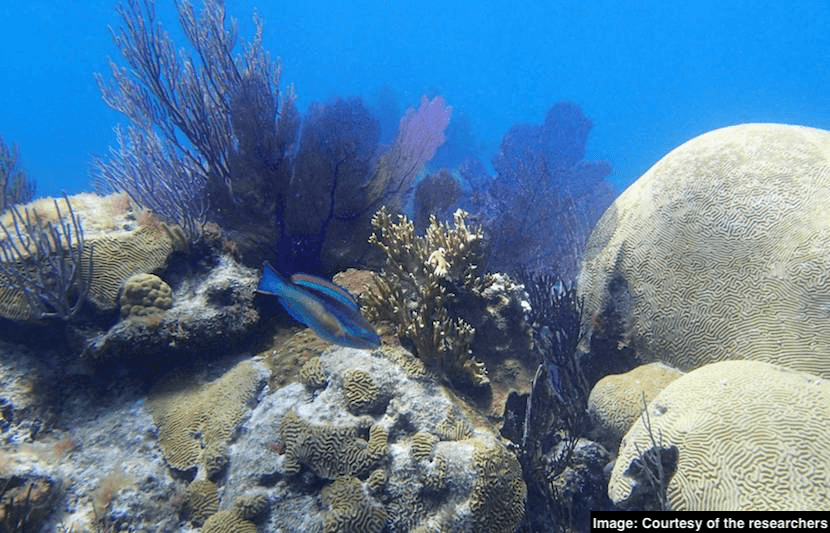Every year, hundreds of millions of tons of nitrogen fertilizers seep into nearby bodies of water, wreaking havoc on marine life by causing algal blooms and creating massive dead zones.
However, while nitrogen pollution is increasingly recognized as an urgent threat to marine ecosystems in coastal areas across the world, little is known about how it is affecting life far offshore in the open ocean.
Now, a new study of nitrogen levels in the North Atlantic Ocean off the East Coast of the U.S. suggests that the effects may not be as severe as expected.
In the study, a team of Princeton University researchers analyzed the nitrogen levels present in the skeletons of coral samples near the island of Bermuda, including a sample from a 130-year-old living brain coral located 10 feet below the surface on Hogg Reef, which lies about 6 miles from the mainland.
In doing so, the researchers were able to determine the amount of manmade nitrogen present in the body of water and compare it to historic nitrogen levels.
They found no evidence of increased nitrogen levels over the past several decades.
The finding is surprising, as it contradicts estimates made by computer models, said Xingchen (Tony) Wang, who worked on the study as a doctoral student at Princeton and is now a postdoctoral scholar at the California Institute of Technology.
Prior to this study, the area off the coast of Bermuda was thought to be one of the regions most heavily affected by nitrogen pollution.
The small, picturesque island known for its pink beaches, sits in the middle of the North Atlantic about 650 miles away from North Carolina. Environmental scientists have long thought that the area surrounding the island was significantly polluted by airborne nitrogen released from the U.S. mainland.
“Prior to our study, scientists mainly relied on computer models to tell which parts of the ocean are most polluted by human-derived nitrogen,” said Wang.
“According to these computer models, the North Atlantic Ocean has already been heavily influenced by nitrogen pollution from the U.S. However, there have not been enough modern measurements to calibrate the models, possibly explaining the difference with our findings.”
Whereas computer models can only provide estimates, coral skeletons, like layers of sediment, provide scientists with something of a historical archive of environmental changes, Wang explained.
“Once settled during the larval stage, corals sit in one place and grow their skeleton annually like tree rings,” he said. “Moreover, a lot of different types of information about the ocean are stored in the coral skeleton. Previous studies have mostly focused on using corals to reconstruct ocean temperature changes, but other changes, such as in salinity and heavy metal contamination, can sometimes be reconstructed.
“Thanks to the techniques we have developed over the past several years, we can now use corals to study the history of nitrogen pollution in the ocean.”
While the results bode well for that region of the North Atlantic Ocean, nitrogen pollution remains a major problem across the world. An earlier study by the same team of researchers found that nitrogen levels in the South China Sea have grown sharply in recent decades.
The researchers attribute the difference between the findings in the two studies to a few different potential factors.
Foremost, the use of coal and nitrogen fertilizer in China has increased dramatically, significantly outpacing the U.S. Wang said that coal and fertilizer consumption in China is currently three to four times higher than in the U.S.
Wang also noted that the South China Sea is also a partially enclosed basin, which makes it harder for nitrogen pollution to be diluted away, and the South China Sea coral samples were found closer to the coast, and therefore closer to pollution sources.
The effects of nitrogen pollution are felt — and are, in fact, visible — across the entire world. When excess nitrogen, a powerful fertilizer, enters a water source, it disrupts the balance of nutrients in the ecosystem.
“Nitrogen is an essential nutrient required by all life in the ocean. But too much of a good thing is often a bad thing,” Wang said.
“When too much nitrogen is released into a body of water, blooms of algae can result. The algal biomass produced is in turn degraded by bacteria, a process that consumes oxygen in the water. If the oxygen is consumed faster than it can be supplied, the water becomes too oxygen-poor for many aquatic organisms, producing what is sometimes called a ‘dead zone.’ ”
Hundreds of dead zones occur annually across the world, typically in areas where there is heavy agricultural or industrial activity. In one of the most infamous examples, every summer, nitrogen from the Mississippi River seeps into the Gulf of Mexico to create a massive dead zone.
So the finding should be celebrated, but nitrogen pollution — among other effects of human activity on the environment — remains a threat to marine ecosystems across the world.
“While our results are good news with regard to open ocean nitrogen pollution, coral reefs around the world are in peril, most importantly because of global warming,” said Wang.
“This study indicates that our concerns for coral reefs should probably focus on the coral death that can result from global warming.”



